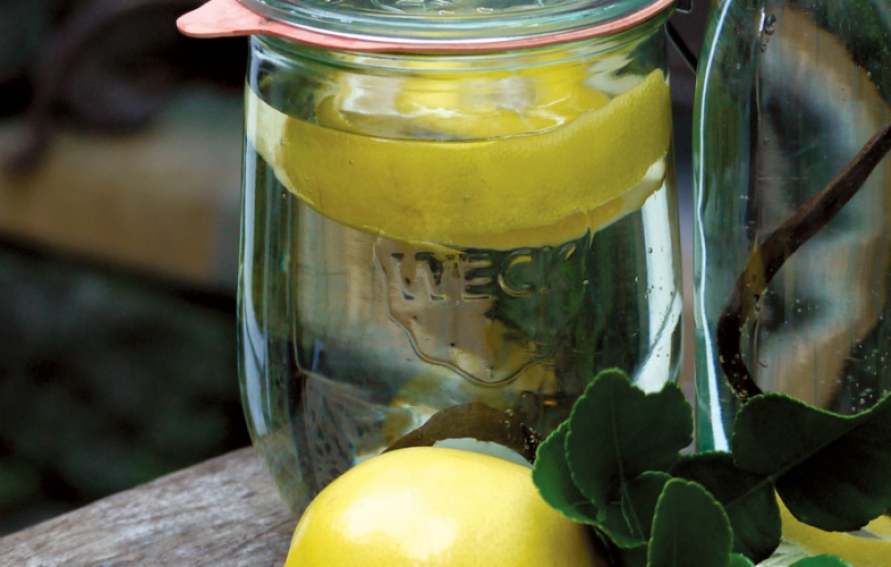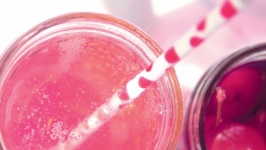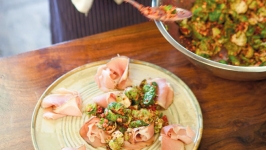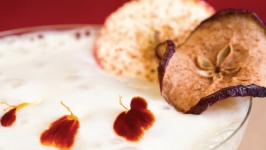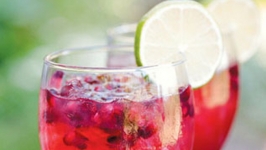Ingredients
- 1 (750-milliliter) bottle dry or fruity white wine
- 2 Meyer lemons, untreated
- 1/2 vanilla bean
- 1/4 pound granulated sugar
- 3/4 cup eau de vie, grappa or unflavoured vodka
Preparation
Choose a clean, dry, open-mouthed jar large enough to hold all the ingredients. Zest the 2 lemons in long peels. Place the peels in the jar along with 1/4 of 1 of the lemons. Add the remaining ingredients, cover the jar and let stand for four days, unrefrigerated, stirring occasionally.
Strain the Vin de Citron through a cheese-cloth-lined sieve into a clean, dry bottle and cork or otherwise close. Discard the other ingredients.
Store the wine in a cool, dark place or in the refrigerator. It will keep up to 6 months.
To serve, pour over ice or serve chilled.
About this recipe
The ripe lemons of winter seem to always arrive in perfect time with my desire to make Vin de Citron, a vin maison, or house-made wine, that is made by infusing wine with lemon and sugar, then fortifying it with eau de vie, grappa or vodka.
When I first tell people about this drink, they often say, “Oh, I love limoncello.” However, limoncello is quite different from Vin de Citron because limoncello is a liqueur rather than a fortified wine. Limoncello has a higher alcohol content, and it is typically served as a digestif, or after-dinner drink, while Vin de Citron is served as an apéritif.
I first made Vin de Citron with a French friend in Provence, purchasing organic lemons—maybe the Eureka or Lisbon varieties—at the local open market. Next we went to a nearby winery and bought 10 liters of Vin de Pays Blanc, most likely a blend of Ugni Blanc, Rolle and Viognier at a cost of about 3 euros (at that time less than $3) a liter. From there we went to my house and she proceeded to take me through the process step by step. Even though, as I discovered, it is very easy to make, the concept was an entirely new one for me.
Since that initiation, I’ve made Vin de Citron many times, but here in California I make it with Meyer lemons, because when my husband and I moved into the old wooden farmhouse where we live now, the first fruit trees we planted were Meyers—20 of them. We spaced them to frame the south side of the house, from sun porch to kitchen. Now thriving, we keep them trimmed, like a hedge, to just about seven feet, in easy reach of the kitchen windows.
I have to admit I was as fascinated by the history of the Meyer lemon as I was enamored of its delicate skin and sweet tart juice. Like most citrus, the Meyer lemon originated in China, and it is thought to be the result of a naturally occurring cross between a lemon and an orange or mandarin. Frank N. Meyer, a plant explorer for the USDA, introduced it into the United States in 1908, and it became a popular backyard fruit in California and elsewhere in the Southwest, partly because it is more cold tolerant than other lemons.
Then, in the 1940s, it was discovered that the Meyer lemon was a carrier of a deadly citrus disease and the trees were pulled from nursery propagations and destroyed, except for one strain that was found free of the disease. Happily, by the 1970s, this Improved Meyer Lemon clone was deemed virus free and was so certified by the University of California. This is the tree that is sold at nurseries today—and the variety that we planted now almost 25 years ago.
In making your own Vin de Citron, any lemon variety will suffice, but they should be organic or sustainably grown and free from any pesticides. The recipe I’ve included here is for a single bottle, but for the holidays consider making up a batch of 10 bottles or so for gift-giving.
Georgeanne Brennan is the author of more than 30 cookbooks and garden books. She lives in Winters, where she writes, cooks and runs her new business, La Vie Rustic. LaVieRustic.com

